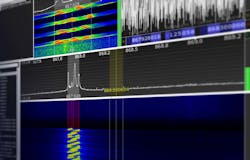Air Force researchers pick BlackHorse Solutions for autonomous RF and microwave sensors and software project
WRIGHT-PATTERSON AFB, Ohio – U.S. Air Force researchers needed an RF and microwave specialist to develop ways of improving the autonomous operation of software defined radios (SDRs) and software. They found their solution from BlackHorse Solutions Inc. in Herndon, Va.
Officials of the Air Force Research Laboratory at Wright-Patterson Air Force Base, Ohio, have announced a $5.4 million contract to BlackHorse for the Multi-Spectral Sensing Technologies Research and Development (MuSTeR) program to develop RF and electro-optical sensors for offensive, defensive, and integrated offensive and defensive systems.
BlackHorse engineers will concentrate on improved RF sensing systems for situational awareness and targeting applications. Leading the MuSTeR program are experts in the Sensors Directorate of the Air Force Research Lab's Multispectral Sensing and Detection Division.
Last April the Air Force awarded a $1.4 million contract to Senseeker Engineering Inc. in Santa Barbara, Calif., to develop an advanced large-format high-dynamic-range long wave infrared (LWIR) digital pixel readout integrated circuit (DPROIC) for airborne infrared and track (IRST) applications as part of the MuSTeR program.
MuSTeR seeks to enhance the state-of-the-art in U.S. military sensor system research by using the entire electromagnetic spectrum to deliver next-generation capabilities for global persistent awareness. SRI International in Menlo Park, Calif., also is participating in the MuSTeR program.
Several RF and microwave research initiatives are involved in the MuSTeR program, which include antenna technologies and electromagnetic (EM) scattering; RF sensor systems technology; waveform phenomenology design and applications; ultra-sensitive receivers for signals intelligence; fully adaptive radar; radar communications co-existence for enabling 5G technologies and beyond; and advanced digital multifunction arrays.
Antenna technologies and electromagnetic (EM) scattering seeks to advance detection, tracking, and data fusion for difficult targets, advanced antenna and scattering theory, situational awareness, and to develop architectures and algorithms for surveillance, navigation, and communications.
RF sensor systems technology will investigate revolutionary and revolutionary improvements to RF sensing systems for situational awareness and targeting applications.
Waveform phenomenology design and applications centers on waveform agility to use all possible degrees of freedom; explore noise-like waveforms and interference-tolerant waveforms; low probability of intercept; low probability of detection; and low-probability of exploitation waveforms.
Ultra-sensitive receivers for signals intelligence seeks to comprehend the physics-based relationship between a receiver noise floor and sensitivity. The long-term research goal is to enable a RF receiver capable of sequential search and analysis under dense and complex signal conditions to enable revolutionary sensor payloads.
Fully adaptive radar seeks to exploit all available degrees-of-freedom on transmit and receive make the most of target detection, tracking, and classification performance.
Radar communications co-existence for enabling 5G technologies and beyond seeks to capitalize on promising techniques that facilitate co-existence of radar and communications in a given spectral band using a host of diversity mechanisms.
Advanced digital multifunction arrays seeks to develop sensors able to perform digital beamforming while exploiting power, polarization, spatial, spectral, and temporal diversity to perform several tasks simultaneously through an intelligent sensor resource manager.
For more information contact BlackHorse Solutions online at https://blackhorsesolutions.com, or the Air Force Research Laboratory Multispectral Sensing and Detection Division at www.afrl.af.mil.
About the Author
John Keller
Editor-in-Chief
John Keller is the Editor-in-Chief, Military & Aerospace Electronics Magazine--provides extensive coverage and analysis of enabling electronics and optoelectronic technologies in military, space and commercial aviation applications. John has been a member of the Military & Aerospace Electronics staff since 1989 and chief editor since 1995.
